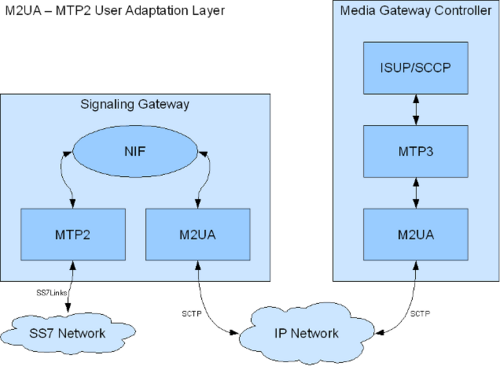M2UA
From TBwiki
(Difference between revisions)
(add revise on major) |
(→References) |
||
| Line 14: | Line 14: | ||
TelcoBridges supports M2UA as part of its [[SIGTRAN]] implementation. | TelcoBridges supports M2UA as part of its [[SIGTRAN]] implementation. | ||
| + | |||
| + | == Configuration == | ||
| + | |||
| + | *[[Toolpack:Protocol_Stack_Settings_A#M2UA|M2UA configuration v2.8]] | ||
| + | *[[Web_Portal_Tutorial_Guide_v2.7#M2UA|M2UA configuration v2.7]] | ||
== References == | == References == | ||
Revision as of 10:37, 3 March 2015
The M2UA (Message Transfer Part 2 User Adaptation Layer) is used to interface MTP2 of the signaling gateway to the MTP3 of a media gateway controller. M2UA can also be seen as way to extend a MTP2 link. An M2UA link is always bound to an MTP2 link.
Here is a diagram of a setup using M2UA:
As you can see the M2UA layer can interface with either a NIF or MTP3 layer. Therefore M2UA has 2 modes of operation. Toolpack can configure M2UA in both modes.
TelcoBridges and M2UA
TelcoBridges supports M2UA as part of its SIGTRAN implementation.
Configuration
References
- Article at Protocols.com
- RFC 3331 Signaling System 7 (SS7) Message Transfer Part 2 (MTP2) - User Adaptation Layer
